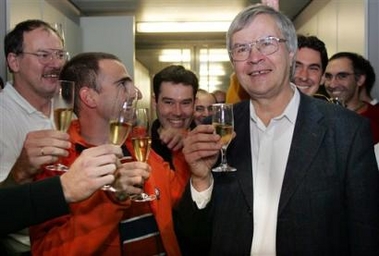|
Americans, German win Nobel physics prize
(AP)
Updated: 2005-10-04 21:57
Americans John L. Hall and Roy J. Glauber and German Theodor W. Haensch won
the 2005 Nobel Prize in physics Tuesday for work that could lead to better
long-distance communication and more precise navigation worldwide and in space.

Theodor Haensch, right, professor of physics,
is cheered by students and coworkers at his office in Munich, southern
Germany, Tuesday, Oct. 4, 2005 after he learned that he had been awarded
the Nobel prize for physics 2005. Americans John L. Hall and Roy J.
Glauber and German Theodor W. Haensch won the 2005 Nobel Prize in physics
for their work in advancing the precision of optic technology that could
lead to clear long-distance communication worldwide and beyond.
[AP] |
The prize was given to the three for
their work in applying modern quantum physics to the study of optics. Engineers
have used their observations to improve lasers, Global Positioning System
technology and other instruments.
Glauber, 80, of Harvard University, took half of this year's Nobel for
showing in the 1960s how the particle nature of light affects its behavior under
certain circumstances. Although those conditions are rarely observed in nature,
they are often relevant in sophisticated optical instruments.
Hall, 71, of the University of Colorado, and Haensch, 63, of the
Ludwig-Maximilian-Universitaet in Munich, won "for their contributions to the
development of laser-based precision spectroscopy, including the optical
frequency comb technique." Their research determined the color of light at the
atomic and molecular level. Haensch used evenly spaced laser pulses to determine
the frequencies and Hall refined the technique.
Hall and Haensch will split one half of the $1.3 million prize, with Glauber
receiving the rest.
"It's a huge surprise, a great pleasure," Hall said, noting the work was a
team effort.
Speaking from his office in Munich, Haensch called the award a high point of
his career.
"I was speechless but of course very happy, exuberant," he said. "Now, I am
trying to get used to this."
He said the fruits of their work could eventually be applied to improving
communication across the globe and beyond. The research could also be useful in
helping spacecraft navigate more accurately on long journeys, or creating better
digital animation.
"Eventually, we may be able to enjoy three-dimensional holographic movies,"
Haensch said.
"The important contributions by John Hall and Theodor Haensch have made it
possible to measure frequencies with an accuracy of 15 digits," the academy
noted. "Lasers with extremely sharp colors can now be constructed, and with the
frequency comb technique precise readings can be made of light of all colors.
"This technique makes it possible to carry out studies of, for example, the
stability of the constants of nature over time and to develop extremely accurate
clocks and improved GPS technology."
Borje Johansson, a member of the Royal Swedish Academy of Sciences, called
the academy's choice "a typical physics prize."
"First someone breaks down a barrier, and then things happen," Johansson
said. "The common man can have great use of this."
Sune Svanberg, chairman of the Nobel Committee for Physics, said Glauber can
rightly be considered the father of quantum optics, and that his theories paved
the way for the discoveries made by Hall and Haensch.
Until Glauber published his theories in 1963, scientists had dismissed the
idea that the quantum theory, originally developed by Albert Einstein, could be
applied to the field of optics.
"There were completely different ideas back then about how to view this,"
Svanberg said. "His results are fundamental for our modern understanding of the
behavior of light."
Hall works for JILA, an institute run by the University of Colorado and the
National Institute of Standards and Technology. Two other JILA physicists, Eric
A. Cornell and Carl E. Wieman, won the Nobel in physics in 2001.
JILA originally stood for the Joint Institute for Laboratory Astrophysics.
However, JILA's fellows decided to keep the name but drop the meaning in 1994 as
the scope of its research widened.
Of the six Nobels, the physics prize has perhaps the broadest scope of
research, making speculation ahead of the announcement difficult.
Alfred Nobel, the wealthy Swedish industrialist and inventor of dynamite who
endowed the prizes, left only vague guidelines for the selection committee,
saying in his will that the prize should be given to those who "shall have
conferred the greatest benefit on mankind" and "shall have made the most
important discovery or invention within the field of physics."
In the past decade, winning physics discoveries have ranged from explaining
the makeup of faraway galaxies to creating high-speed electronics that led to
breakthroughs in how information is transmitted worldwide at superfast speeds.
Last year's prize was given to Americans David J. Gross, H. David Politzer
and Frank Wilczeck for their explanation of the force that binds particles
inside an atomic nucleus.
The prize is the second Nobel to be announced this week. On Monday,
Australians Barry J. Marshall and Robin Warren won the 2005 Nobel Prize in
physiology or medicine for proving, partly by accident, that bacteria and not
stress was the main cause of painful ulcers of the stomach and intestine.
The awards for chemistry, peace and literature will be announced through the
end of the week, with the economics prize to be awarded Oct. 10.
The prizes will be awarded by Sweden's King Carl XVI Gustaf at a ceremony in
Stockholm on Dec. 10.
|
 | | | Bali bombings kill 25, 100 injured | | |  | | | US millionaire ready for space trip | | |  | | | Los Angeles fire | | |
|
| |
 |
|
 |
|
|
Today's
Top News |
|
|
|
Top World
News |
 |
|
 |
|
|
|
|
|
|


